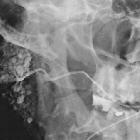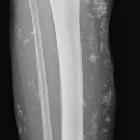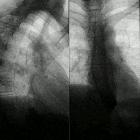interstitial lung disease








Interstitial lung disease (ILD) is an umbrella term that encompasses a large number of disorders that are characterized by diffuse cellular infiltrates in a periacinar location. The spectrum of conditions included is broad, ranging from occasional self-limited inflammatory processes to severe debilitating fibrosis of the lungs.
Terminology
Interstitial lung disease is considered a misnomer by some, as many of the diseases also involve the alveolar spaces.
Clinical presentation
Interstitial lung diseases classically produce the "3Cs": cough, clubbing of the nails, and coarse crackles on auscultation .
Functional respiratory tests commonly show an abnormal restrictive pattern and reduced diffusing capacity.
Pathology
Etiology
The radiological appearances are not specific for the underlying cause of diffuse lung disease in many cases. It is therefore key to determine whether there is an underlying cause for the changes. A number of precipitants can cause diffuse interstitial disease such as:
- smoking
- organic dusts (causing extrinsic allergic alveolitis)
- inorganic dusts (causing pneumoconioses)
- gases or fumes
- drugs
- radiation
- infection
Eliciting a history of underlying systemic disease is also helpful since they may involve the lungs in a diffuse and infiltrative manner. Examples include:
- granulomatous diseases, e.g. sarcoidosis, Langerhans cell histiocytosis
- neoplasia
- primary, e.g. lymphoma, other lymphoproliferative diseases
- secondary, e.g. pulmonary metastases, lymphangitis carcinomatosis
- vasculitis
- inherited diseases, e.g. neurofibromatosis
- autoimmune and collagen vascular diseases
- systemic lupus erythematosus
- rheumatoid arthritis
- progressive systemic sclerosis
- anti-Jo-1 antibody positive interstitial lung disease
- ankylosing spondylitis
- Sjögren syndrome
- mixed connective tissue disease
- psoriasis - pulmonary manifestations of psoriasis
- interstitial pneumonia with autoimmune features
- primary biliary cholangitis / primary biliary cirrhosis
- miscellaneous, e.g. amyloidosis, alveolar proteinosis
Where a cause is not determined, the idiopathic interstitial pneumonia (IIP) should be considered:
- usual interstitial pneumonia (UIP): idiopathic pulmonary fibrosis
- cryptogenic organizing pneumonia (COP): previously termed BOOP
- non-UIP IIP
- non-specific interstitial pneumonia (NSIP): non-smokers
- respiratory bronchiolitis-interstitial lung disease (RB-ILD): smokers
- desquamative interstitial pneumonia (DIP): end-state of RB-ILD
- lymphoid interstitial pneumonia (LIP): women
- acute interstitial pneumonitis (AIP)
- other entities
Mnemonic: All Idiopathic Chronic Lung Diseases aRe Nonspecific
Radiographic features
The diffuse lung diseases tend to cause infiltrative opacification in the periphery of the lung, but patterns vary among the different etiologies. Please refer to the articles in each specific etiology listed above for specific details on their imaging pattern.
See also
- interstitial lung abnormality
- interstitial lung pattern - radiograph
Siehe auch:
- Morbus Bechterew
- Lymphangiosis carcinomatosa
- Sarkoidose
- Rheumatoide Arthritis
- Kryptogene organisierende Pneumonie (COP)
- Hypersensitivitätspneumonitis
- Lymphom
- Dermatomyositis
- Systemische Sklerodermie
- systemischer Lupus Erythematodes
- Amyloidose
- Lungenmetastasen
- Alveolarproteinose
- Sjögren-Syndrom
- Pneumonokoniose
- lymphozytisch interstitielle Pneumonie
- gewöhnliche interstitielle Pneumonie (UIP)
- non specific interstitial pneumonia (NSIP)
- mixed connective tissue disease
- Strahlenpneumonitis
- pulmonary interstitium
- combined pulmonary fibrosis and emphysema
- respiratory bronchiolitis interstitial lung disease
- pulmonale Eosinophilie
- Akute interstitielle Pneumonie
- Desquamative interstitielle Pneumonie (DIP)
- anti synthetase syndrome
- interstitielle Pneumonie
- connective tissue disease - associated interstitial lung disease
- All Idiopathic Chronic Lung Diseases aRe Nonspecific
und weiter:
- Bronchopneumogramm
- idiopathic interstitial pneumonia (mnemonic)
- idiopathische Lungenfibrose
- hard metal pneumoconiosis
- asbestos body
- pulmonary arterial hypertension classification - third world symposium on PAH
- ferruginous body
- CTD-ILD
- Lungengerüstvergröberung
- Idiopathische interstitielle Pneumonie
- pulmonary hypertension and interstitial lung disease in systemic sclerosis

 Assoziationen und Differentialdiagnosen zu Interstitielle Lungenerkrankung:
Assoziationen und Differentialdiagnosen zu Interstitielle Lungenerkrankung:
























